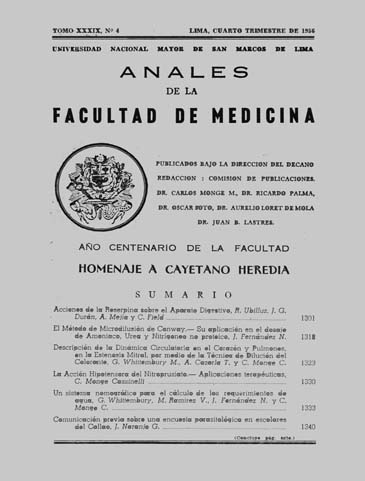Circulatory dynamics description in the heart and lungs, in mitral stenosis, through dye dilution technique
DOI:
https://doi.org/10.15381/anales.v39i4.10748Abstract
20 cases were studied typical mitral stenosis, ranked according to Dexter degrees, through the dye dilution curve in the following: circulatory times. cardiac index, central volume (pulmonary blood volume, Newman), intrathoracic volume (Hamilton), blood volume. Compared with normal values for sea level indicated by us. In parallel with the severity of the disease, circulation times were prolonged, decreased cardiac index and increased blood volume. Expressed in absolute figures, the central volume (pulmonary blood volume) increased in parallel with the severity of the disease; but expressed as a percentage of the blood volume, the increase was significant only in grade III patients, the intrathoracic volume did not change significantly. There is a statistically significant correlation between the central volume and intrathoracic volume. Our work shows that there is no systematic increase in the percentage of blood in the lungs.Downloads
Published
1956-12-31
Issue
Section
Trabajos originales
License
Copyright (c) 1956 Guillermo Whittembury M., Alberto Cazoria T., Carlos Monge C.

This work is licensed under a Creative Commons Attribution-NonCommercial-ShareAlike 4.0 International License.
Those authors who have publications with this magazine accept the following terms:
- Authors will retain their copyrights and guarantee the journal the right of first publication of their work, which will be simultaneously subject to Creative Commons Attribution License that allows third parties to share the work as long as its author and its first publication this magazine are indicated.
- Authors may adopt other non-exclusive licensing agreements for the distribution of the version of the published work (eg, deposit it in an institutional electronic file or publish it in a monographic volume) provided that the initial publication in this magazine is indicated.
- Authors are allowed and recommended to disseminate their work over the Internet (eg: in institutional telematic archives or on their website) before and during the submission process, which It can produce interesting exchanges and increase quotes from the published work. (See El efecto del acceso abierto ).
How to Cite
1.
Whittembury M. G, Cazoria T. A, Monge C. C. Circulatory dynamics description in the heart and lungs, in mitral stenosis, through dye dilution technique. An Fac med [Internet]. 1956 Dec. 31 [cited 2024 Jul. 17];39(4):1323-9. Available from: https://revistasinvestigacion.unmsm.edu.pe/index.php/anales/article/view/10748















